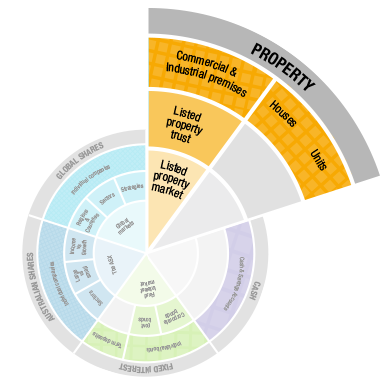Shares and property are considered as ‘growth’ assets and have historically delivered higher returns on investment than so called ‘defensive’ assets like fixed interest and cash, albeit with substantially more ups and downs along the way.
The chart below also splits the asset classes into sub categories, with each one representing a level that you can invest at.

The three levels of investing
Level 1 (the outer coloured ring in the above chart): At this level you can invest directly in individual assets, such as shares in Australian or international companies, bonds issued by companies or governments, a house or a unit
Level 2 (the middle ring): This is where you can invest in sectors within an asset class, such as a group of shares from a particular industry, a stake in a portfolio of non-residential properties, or a slice of the bond market
Level 3 (the inner ring): Here you can effectively invest in an entire asset class, such as the broad Australian or global share markets, the non-residential property or bond markets.
Australian shares

Take Australian shares for example. At Level 1 are individual companies. There are more than 2,000 companies listed and available to be bought on the Australian Securities Exchange. That’s a lot to choose from.
They range from big household names worth billions of dollars like CBA, Westpac, Telstra and Woolworths, to small companies that many of us would never have heard of. All of which come with their own benefits and risks.
At Level 2, you’ll see Australian shares divided into sub categories. Here, you can effectively buy a small stake in a group of companies with a common theme, through a single purchase, which saves you choosing specific companies.
This includes industry sectors, such as financials or resources; large or small companies; and income or growth, which groups companies according to the likelihood of them paying dividends or growing quickly, for example.
At Level 3 you can invest in the broad Australian share market, again through a single purchase.
Rather than picking individual companies or even sectors or themes, you can buy into a group of shares that is put together with the aim of representing the market itself, by matching a broad-based index such as the ASX 200.
The ASX 200 measures the combined share price performance of the largest 200 companies listed on the ASX.
Global shares

It’s the same with global shares. At Level 1 you can buy shares in thousands of individual companies like Apple and Facebook in the US, for instance, or Nestle and GlaxoSmithKline in Europe.
Alternatively, at Level 2 you can invest in a collection of assets through a single purchase, such as global healthcare companies; an index of US, Japanese, European or emerging market companies; or groups of large or small companies from a particular country or region, for example.
And if you want to invest in a group of international shares from all around the world, you can do that too, also through one transaction, at Level 3.
Fixed interest

It’s a similar story with fixed interest, which includes term deposits, as well as both corporate and government bonds.
With term deposits, there’s just one level to invest. You either put your money into one or you don’t. But with bonds, you can choose individual investments from a broad selection of options at Level 1, or you can invest in a subset of that broad selection at Level 2, or even the broad selection itself at Level 3.
So on the one hand, you choose a bond that’s been issued by a single company or government, while on the other you invest in a pool of bonds from a variety of issuers.
Property

The most obvious area of property investment is ‘residential’, which is essentially buying houses or apartments. Because these are individual direct investments, they would sit in Level 1.
But if that doesn’t suit you as an investment opportunity or you want to add some variety to your existing property assets, then you can also invest in non-residential property, through the share market.
As illustrated in Level 1, this could include buying commercial premises or warehouses. While this might seem like a strange choice, you can also invest a much smaller amount in a collection of property assets such as offices or shopping centres at Level 2, just as you invest in sub categories of the share market.
You can effectively own a slice of a whole index of listed property assets by investing at Level 3.
These types of non-residential properties can offer the potential for rental income and capital growth, in the same way that houses and units do, and investing in a group of them, through one purchase, can reduce the risk of investing in individual assets.
It should be noted that all investments come with some degree of risk, which should be considered in the context of your personal circumstances before making decisions.









